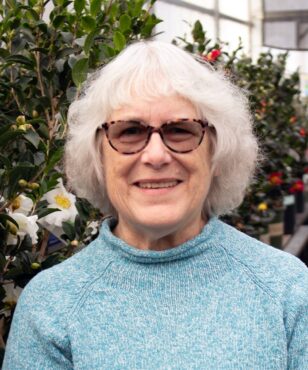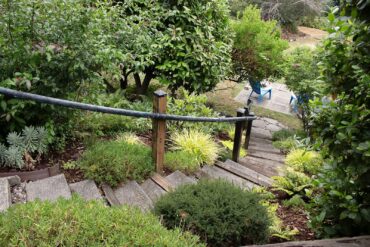 Therry Frey and Michael Harrison love to travel to new and old favorite places each year. But the rest of the time, they spend hours out in their gardens, which are best described as luscious. Seven years ago, this well-traveled couple moved to their Keyport home, located on a steep 2.5 acres that slope down to the bay.
Therry Frey and Michael Harrison love to travel to new and old favorite places each year. But the rest of the time, they spend hours out in their gardens, which are best described as luscious. Seven years ago, this well-traveled couple moved to their Keyport home, located on a steep 2.5 acres that slope down to the bay.
When they first saw the home and property, established in 1976, they could tell it had once been landscaped but was now covered in blackberries and overgrown vegetation. They both pitched in, hired helpers and began restoring and re-creating their piece of heaven overlooking the bay.
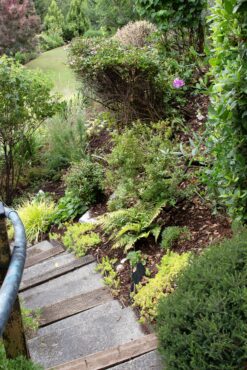 The front entrance to the property features a curved border of raised beds edged with a wall of flat stones hand-built by Frey. Traveling around the corner from the front area, visitors encounter sloping land, terraced beds, a hillside festooned with masses of perennials and annuals that change with the seasons, a huge hillside lawn that ends at a naturalized mass of native plants (and, of course, blackberries) that lead down to the shoreline.
The front entrance to the property features a curved border of raised beds edged with a wall of flat stones hand-built by Frey. Traveling around the corner from the front area, visitors encounter sloping land, terraced beds, a hillside festooned with masses of perennials and annuals that change with the seasons, a huge hillside lawn that ends at a naturalized mass of native plants (and, of course, blackberries) that lead down to the shoreline.
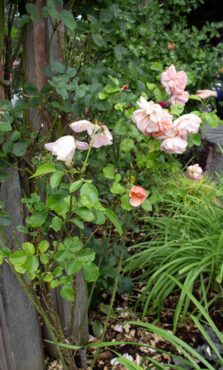 Evergreen shrubs and trees provide a framework and backdrop for many of the plantings throughout the landscape but Frey’s favorite plants are an ever-changing palette of perennials and annuals that add splashes of enticing colorful blooms throughout all of the gardens surrounding their home. One hillside is festooned with acollection of perennials started from seed. She edits out plants, sharing with friends and neighbors, and adds more plants from seed each year. Seeds were purchased from American Wildlife Meadows and were chosen for this region of the Pacific Northwest.
Evergreen shrubs and trees provide a framework and backdrop for many of the plantings throughout the landscape but Frey’s favorite plants are an ever-changing palette of perennials and annuals that add splashes of enticing colorful blooms throughout all of the gardens surrounding their home. One hillside is festooned with acollection of perennials started from seed. She edits out plants, sharing with friends and neighbors, and adds more plants from seed each year. Seeds were purchased from American Wildlife Meadows and were chosen for this region of the Pacific Northwest.
New beauties carpet the hillside each year — red poppies one year, white daisies the next year and golden rudbeckia after that, all providing sweeps of floral profusion. Frey loves designing the garden areas but says, “I just buy everything I like.”
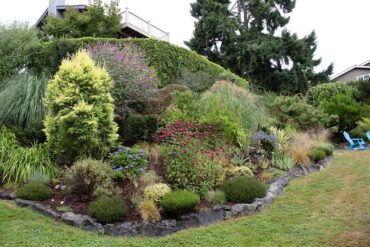 She adds that her color design happens sometimes by accident rather than planned. “A friend gave me sunflower seeds that I threw out by the Russian sage, and they look great together,” she says.
She adds that her color design happens sometimes by accident rather than planned. “A friend gave me sunflower seeds that I threw out by the Russian sage, and they look great together,” she says.
Frey loves getting ideas from books and nurseries, and especially likes perusing gardening and design magazines. Some of her favorites are those showing English gardens.
Harrison also has his favorite plants. Tucked into sunny spots are banana plants and palm trees. His first palm tree came from Oregon; recently, he found one at Home Depot. His banana trees do not bear fruit yet and are described as “hardy banana,” but are more like bushes than trees. In the first year, the plant grew 6 feet tall and the couple like the pods that would produce bananas in warmer climates.
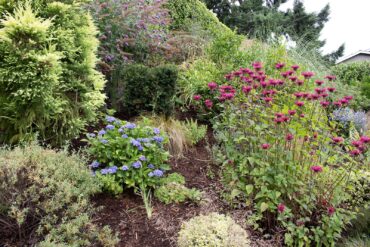 “Michael loves dividing and transplanting the banana bushes sprouted from the original plant and shares these sprouts with friends, too,” Frey says.
“Michael loves dividing and transplanting the banana bushes sprouted from the original plant and shares these sprouts with friends, too,” Frey says.
Restoring and Maintaining the Gardens
When they purchased the property, the couple had to remove what seemed like acres of blackberries. To this day, Harrison still takes time each year to remove as many blackberries as possible. But there is a sweep of blackberries on the edge to hopefully entice deer away from the gardens while also providing berries for pies and preserves.
Next came building borders around the flat and terraced beds, with lots and lots of soil, compost and mulch. The amendments at first were done with trucks full of materials delivered at the top of the property and then wheelbarrowed down into the garden areas. Luckily and happily, they hired help for this arduous task. They had a crew for the first two years and much of the work was done by hand and with shovels because of the slope of the property.
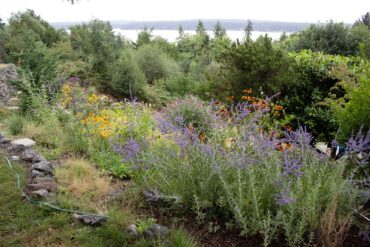 “Now when I want to refresh various existing areas, I purchase bags (that I can carry) of soil and mulch and then place individual bags in the areas I’ve chosen. I put out 65 bags of mulch last year to get ready for the Keyport Garden Tour,” Frey says. “I love designing so much more than weeding and luckily, we have a crew come in three times a year to do some of the work to help us.”
“Now when I want to refresh various existing areas, I purchase bags (that I can carry) of soil and mulch and then place individual bags in the areas I’ve chosen. I put out 65 bags of mulch last year to get ready for the Keyport Garden Tour,” Frey says. “I love designing so much more than weeding and luckily, we have a crew come in three times a year to do some of the work to help us.”
They also hired someone to maintain and perform tree work. Harrison began mowing all the grassy area by hand, but now has a hired crew to mow.
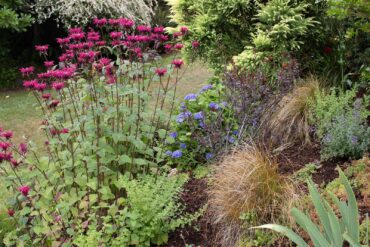 One challenge they encountered is marauding deer. “They eat everything! They even eat tulips and arborvitaes,” she says.
One challenge they encountered is marauding deer. “They eat everything! They even eat tulips and arborvitaes,” she says.
Weed removal is also a continual process. But Frey considers it exercise and enjoys being out in the gardens as many mornings as possible.
The massive hillside of color began as a “COVID insanity project,” Frey says. It started with red and blue blooms the first year, changing to white Shasta daisies the next and golden rudbeckia the third year. “I have no idea what will come up and what color will dominate this year,” she says.
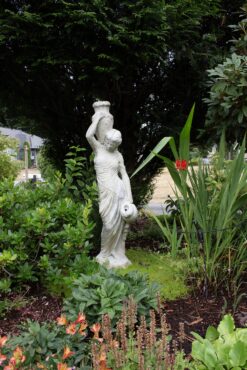 Favorite Plants and Tips from Frey
Favorite Plants and Tips from Frey
Frey loves designing the garden areas, especially grasses that add texture and interest among the shrubs, bulbs and perennials. Her 10 favorites so far are:
- Small red poppies
- Hellebores (she cautions to keep various colors separated because they often cross-breed and where once were all pink blooms, soon white and pink blooms appear, for example)
- Dahlias (she prefers the ones with smaller blooms)
- Calla lilies (which she describes as voluptuous and spectacular)
- Lavender
- Camellias
- Crocosmia (all colors and leaf shapes)
- Borage (with intense blue and pink combinations)
- Irises (all sizes and colors)
- Foxglove
Frey scatters seeds each spring into the flowery hillside. She also scatters seedheads or new packages of seeds in the fall. Bare spots are reseeded with soil and seeds mixed together. Perennials that began from seeds and are now fully grown are divided and whole plants are placed into the soil to grow. The entire area is watered during planting and during dryer times if needed. But mostly, it all thrives once planted.
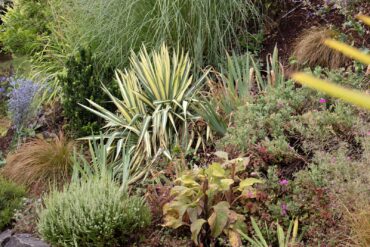 Seven Years of Community
Seven Years of Community
Therry Frey and Michael Harrison are glad they moved to this community seven years ago. Neighbors meet on Tuesdays at the Keyport Mercantile for coffee and chatting. It’s a weekly impromptu group that exchanges ideas and news. It’s quite casual and changes with the times and seasons. Many of them are gardeners who share ideas and even exchange plants. Officers from the Keyport Improvement Club are often there, sharing news of upcoming events and volunteer opportunities to help with community needs or to sign up for various projects.




